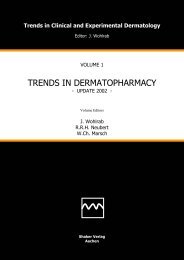Adjuvante Therapie der Atopischen Dermatitis - Wohlrab-net.de
Adjuvante Therapie der Atopischen Dermatitis - Wohlrab-net.de
Adjuvante Therapie der Atopischen Dermatitis - Wohlrab-net.de
Sie wollen auch ein ePaper? Erhöhen Sie die Reichweite Ihrer Titel.
YUMPU macht aus Druck-PDFs automatisch weboptimierte ePaper, die Google liebt.
36 Triggerfaktoren und Prävention<br />
_____________________________________________________________________________________<br />
[21] Guillet G, Guillet MH (1992) Natural history of sensitizations in atopic<br />
<strong><strong>de</strong>r</strong>matitis. A 3-year follow-up in 250 children: food allergy and high risk<br />
of respiratory symptoms. Arch Dermatol 128:187-192<br />
[22] Niestijl Jansen JJ, Kardinaal AFM, Huijbers G, Vlieg-Boerstra BJ,<br />
Martens BPM, Ockhuizen T (1994) Prevalence of food allergy and<br />
intolerance in the adult Dutch population. J Allergy Clin Immunol<br />
93:446-456<br />
[23] Young E, Stoneham M, Petruckevitch A. (1994) A population study of<br />
food intolerance. Lancet 343:1127-1130<br />
[24] Leung DY (1995) Atopic <strong><strong>de</strong>r</strong>matitis: the skin as a window into the<br />
pathogenesis of chronic allergic diseases. J Allergy Clin Immunol<br />
96:302-318<br />
[25] Yarwood JM, Leung DY, Schlievert PM (2000) Evi<strong>de</strong>nce for the<br />
involvement of bacterial superantigens in psoriasis, atopic <strong><strong>de</strong>r</strong>matitis, and<br />
Kawasaki syndrome. FEMS Microbiol Lett 192:1-7<br />
[26] Nomura I, Tanaka K, Tomita H, Katsunuma T, Ohya Y, Ikeda N, Takeda<br />
T, Saito H, Akasawa A (1999) Evaluation of the staphylococcal<br />
exotoxins and their specific IgE in childhood atopic <strong><strong>de</strong>r</strong>matitis. J Allergy<br />
Clin Immunol 104:441-446<br />
[27] Bunikowski R, Mielke ME, Skarabis H, Worm M, Anagnostopoulos I,<br />
Kol<strong>de</strong> G, Wahn U, Renz T (2000) Evi<strong>de</strong>nce for a disease-promoting<br />
effect of staphylococcus aureus-<strong><strong>de</strong>r</strong>ived exotoxins in atopic <strong><strong>de</strong>r</strong>matitis. J<br />
Allergy Clin Immunol 105:814-819<br />
[28] Mempel M, Schmidt T, Weidinger S, Schnopp C, Foster T, Ring J,<br />
Abeck D (1998) Role of Staphylococcus aureus surface-associated<br />
proteins in the attachment to cultured HaCaT keratinocytes in a new<br />
adhesion assay. J Invest Dermatol 111:452-456<br />
[29] Tokura Y, Yagi J, O`Malley M, Lewis JM, Takigawa M, E<strong>de</strong>lson RL,<br />
Tigelaar RE (1994) Superantige<strong>net</strong>ic staphylococcal exotoxins induce T<br />
cell proliferation in the presence of Langerhans cells or class II-bearing<br />
keratinocytes and stimulate keratinocytes to produce T cell-activating<br />
cytokines. J Invest Dermatol 102:31-38<br />
[30] Mempel M, Schnopp C, Hojka M, Fesq H, Weidinger S, Schaller M,<br />
Korting HC, Ring J, Abeck D (2002) Invasion of human keratinocytes by<br />
Staphylococcus aureus and intracellular bacterial persistence represent<br />
haemolysin-in<strong>de</strong>pen<strong>de</strong>nt virulence mechanisms that are followed by<br />
features of necrotic and apoptotic keratinocyte cell <strong>de</strong>ath. Br J Dermatol<br />
146:943-951<br />
[31] Chambers HF, Hackbarth CJ (1989) Methicillin-resistant staphylococci:<br />
ge<strong>net</strong>ics and mechanisms of resistance. Antimicrob Agents Chemother<br />
33:991-994<br />
____________________________________________________________________________<br />
<strong>Wohlrab</strong> J (ed.): <strong>Adjuvante</strong> <strong>Therapie</strong> <strong><strong>de</strong>r</strong> <strong>Atopischen</strong> <strong>Dermatitis</strong><br />
In: Trends Clin Exp Dermatol, Aachen, Shaker, 2005, vol 4



